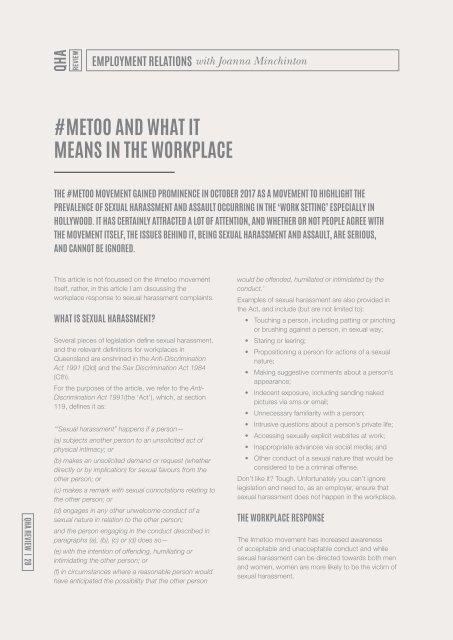QHA_April_Mag
You also want an ePaper? Increase the reach of your titles
YUMPU automatically turns print PDFs into web optimized ePapers that Google loves.
EMPLOYMENT RELATIONS with Joanna Minchinton<br />
#METOO AND WHAT IT<br />
MEANS IN THE WORKPLACE<br />
THE #METOO MOVEMENT GAINED PROMINENCE IN OCTOBER 2017 AS A MOVEMENT TO HIGHLIGHT THE<br />
PREVALENCE OF SEXUAL HARASSMENT AND ASSAULT OCCURRING IN THE ‘WORK SETTING’ ESPECIALLY IN<br />
HOLLYWOOD. IT HAS CERTAINLY ATTRACTED A LOT OF ATTENTION, AND WHETHER OR NOT PEOPLE AGREE WITH<br />
THE MOVEMENT ITSELF, THE ISSUES BEHIND IT, BEING SEXUAL HARASSMENT AND ASSAULT, ARE SERIOUS,<br />
AND CANNOT BE IGNORED.<br />
<strong>QHA</strong> REVIEW | 28<br />
This article is not focussed on the #metoo movement<br />
itself, rather, in this article I am discussing the<br />
workplace response to sexual harassment complaints.<br />
WHAT IS SEXUAL HARASSMENT?<br />
Several pieces of legislation define sexual harassment,<br />
and the relevant definitions for workplaces in<br />
Queensland are enshrined in the Anti-Discrimination<br />
Act 1991 (Qld) and the Sex Discrimination Act 1984<br />
(Cth).<br />
For the purposes of the article, we refer to the Anti-<br />
Discrimination Act 1991(the ‘Act’), which, at section<br />
119, defines it as:<br />
‘“Sexual harassment” happens if a person—<br />
(a) subjects another person to an unsolicited act of<br />
physical intimacy; or<br />
(b) makes an unsolicited demand or request (whether<br />
directly or by implication) for sexual favours from the<br />
other person; or<br />
(c) makes a remark with sexual connotations relating to<br />
the other person; or<br />
(d) engages in any other unwelcome conduct of a<br />
sexual nature in relation to the other person;<br />
and the person engaging in the conduct described in<br />
paragraphs (a), (b), (c) or (d) does so—<br />
(e) with the intention of offending, humiliating or<br />
intimidating the other person; or<br />
(f) in circumstances where a reasonable person would<br />
have anticipated the possibility that the other person<br />
would be offended, humiliated or intimidated by the<br />
conduct.’<br />
Examples of sexual harassment are also provided in<br />
the Act, and include (but are not limited to):<br />
• Touching a person, including patting or pinching<br />
or brushing against a person, in sexual way;<br />
• Staring or leering;<br />
• Propositioning a person for actions of a sexual<br />
nature;<br />
• Making suggestive comments about a person’s<br />
appearance;<br />
• Indecent exposure, including sending naked<br />
pictures via sms or email;<br />
• Unnecessary familiarity with a person;<br />
• Intrusive questions about a person’s private life;<br />
• Accessing sexually explicit websites at work;<br />
• Inappropriate advances via social media; and<br />
• Other conduct of a sexual nature that would be<br />
considered to be a criminal offense.<br />
Don’t like it? Tough. Unfortunately you can’t ignore<br />
legislation and need to, as an employer, ensure that<br />
sexual harassment does not happen in the workplace.<br />
THE WORKPLACE RESPONSE<br />
The #metoo movement has increased awareness<br />
of acceptable and unacceptable conduct and while<br />
sexual harassment can be directed towards both men<br />
and women, women are more likely to be the victim of<br />
sexual harassment.

















